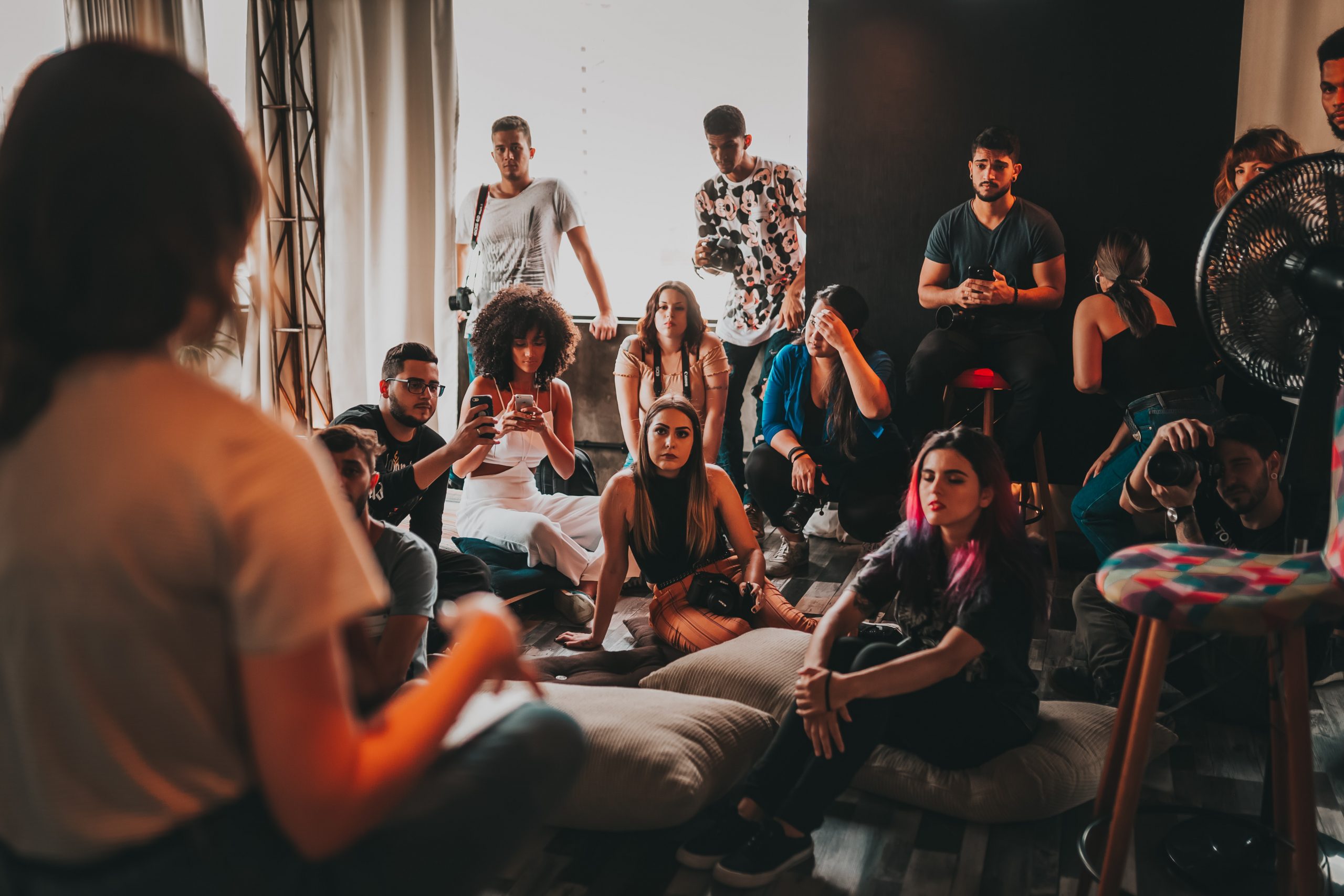Embracing Intercultural Knowledge
Expanding your intercultural knowledge can take different forms, but the key to any of them is personal engagement. No one can really learn about people’s experiences and expand their thinking if this is limited to reading or hearing about other people from someone else.
The following three sections explain how you can embrace and thus expand your intercultural knowledge. Make sure to do something from each section to ensure you have different forms and sources of information and interactions.

1. Engagement
Regardless of the extent to which you can make connections, or how comfortable you feel interacting with people, you can always make the best of the opportunities you have for engagement. Here are some things you can try:
- Reach out to people you have met before that are from different backgrounds. Have more conversations about the way they think and how they see your culture. Find out about their perceptions and preferences beyond tangible elements of culture. You may be surprised by how similar your views are, but even if they are different, remember that understanding

credit: Image by Charlotte May, Pexels license different points of view does not equal agreement; it means you have a better idea of why people think and act in a certain way.
- Start a conversation with students, peers, or co-workers outside of your regular circle. Perhaps they could be from a different cultural group (whether they are domestic or international peers). Remember to suspend judgement by checking your biases and stereotypes.

- Do not sit away from people who seem to “look” different from you because you never know what you may have in common; this is a chance you have to learn about a different way of doing things from that person. Small changes in your actions can translate to great changes in the way you engage with others and can help you deconstruct stereotypes and expand your worldview.

- Take a look around your community. Even if it is heterogeneous, there may be people from different countries or with multicultural backgrounds. Make sure to engage with people from your own and a different group to learn about your cultural self as well as the experiences and stories of other people. You would be surprised by how enriching this experience can be for everyone.

- Join a club at the university ***maybe change to college-Linda and attend cultural events open to the public. Creating these opportunities to meet people will go a long way; it does not take a great effort other than wanting to connect with others while keeping an open mind.
Activity: Engaging with others
As you consider how you engage with others, would you say the following statements are true or false?
Activity: Engaging with others (Text version)
True or false?
- Everything you observe in a person’s attitudes and behaviours are a reflection of their culture.
- If something goes ‘wrong’ in an intercultural situation, it is best to simply walk away and forget about it.
- It is a good idea to start interacting more with people we already know.
Check your Answers in footnote[1]
Activity source: Advancing Intercultural Competence for Global Learners, CC BY-NC 4.0
2. Relatability
Intercultural learning is not centred around differences; it is instead focused on understanding how our cultural identities interact within the same context. When we learn about other cultures, we observe similarities and differences across groups, but that is only a portion of our identity. We can relate to others based on, for example, our cultural background, opinions on issues, individual experiences, intersectional identities, and life histories.

- When studying a topic related to your program that really interests you, find a way to expand your interest by looking at the topic from the perspective of another culture or country. Take a moment to ask yourself, for example, what do engineers consider when building bridges in Guyana, Australia, or Portugal? How do people in rural areas of Guatemala see traditional versus modern medicine? How is physical activity promoted in Chinese cities? What lessons in international development can we learn from Denmark?

- Think about worldly or local events—something that is currently in the news. Focus on learning about how this looks from other perspectives and gaining an understanding of why or how people address the issue in a similar or different way. What does that mean for the population? How is that different from your own case? For example, consider the COVID-19 pandemic: How has this impacted rural or racialized people around you? What is the current situation in other countries? What do you know about how your East Asian friends feel when there is news of anti-Asian racism? What can you do?

- Reflect on the multiple layers of your identity. Perhaps there are aspects of your identity that are not easy to discuss or celebrate with people close to you. Think about how this may look for cultural others; this may be an opportunity to come together and share experiences, perspectives, seek support, and help each other thrive. Sometimes those who understand us best are not in our immediate surroundings because our views or ways of being may not agree. However, it is likely you will find other people with similar views across cultural lines; just because someone is from a different culture does not mean they do not share a similar experience to you.
Activity: Relating to Others
As you consider how you relate to others, would you say the following statements are true or false?
Activity: Relating to Others (Text version)
True or false?
- Developing intercultural competence is aimed at making “best friends” with cultural others.
- One of the greatest mistakes we make is thinking that other people are not interested in connecting with us.
- It is definitely best to focus on learning about a single culture to avoid getting confused.
Check your Answers in footnote[2]
Activity source: Advancing Intercultural Competence for Global Learners, CC BY-NC 4.0
3. Intentionality
It is important to make a conscious effort to observe, listen, converse, interact, learn, share, and appreciate people, their stories, and their cultural background. It is very likely you have already had opportunities to expand your intercultural knowledge, but from now on, you can be more intentional about how to approach those opportunities.
Intentionality slides (Text version)
Travelling abroad allows you to immerse yourself in another culture, provided you are there for more than a couple of weeks, not necessarily for vacationing. While you are abroad, visit local shops, talk to people outside where you are staying, observe how things are done. Learn something new while in the country and ask questions to the local population. Purposefully learn about your surroundings, history, and find ways to understand what is different.
Make the effort to enroll in courses that explore other cultures, look beyond what feels similar or comfortable, learn about other perspectives through your teachers, they are sources of knowledge and will provide you with opportunities to ask questions and can guide you through resources to expand your own understanding of worldviews, issues, and ways of being across cultures.
Make an effort to learn a new language. Languages are important tools without which we would be isolated beings. They allow you to communicate with people when travelling abroad and to make a connection with people around you. Learning a language opens doors, not only when seeking a job, but when you need to access resources, explain something to others, and to gain a better understanding of how culture influences language. Even if you do not become fully proficient, languages will help you better understand other speakers and their cultures.
Be more intentional about developing competencies in the cognitive (gaining knowledge about people and cultures), affective (adapting attitudes and responses), and behavioural (ways of interacting based on cultural tendencies) contexts. Participate in professional development sessions, reach out to campus supports at the university or your workplace, take an interest and motivate peers to engage interculturally, chat about experiences, learn to bridge differences. Challenge bias and stereotypes, be an example of engagement and help others be more open to understanding perspectives.
Read a book from a writer or topic outside your usual choices. Embrace the richness of diversity through the written word, watch movies or series in a different language; they can help you glimpse into behaviours and ways of approaching issues. Remember not to think of these as the only ways to act, otherwise you would be reinforcing stereotypes. Listen to podcasts discussing aspects across cultures, read news from other countries, and make sure to gain different perspectives. How is the same event viewed or portrayed in a different country? If you do not know where to start, click here to access Embracing Intercultural Knowledge: Books and Films, a word document with recommendations for books and films.
Source: Advancing Intercultural Competence for Global Learners, CC BY-NC 4.0
Activity: Being Intentional
As you consider how to be more intentional, would you say the following statements are true or false?
Activity: Being Intentional
True or false?
- It is possible to simply wait for things to happen naturally for other people from other cultures to interact with me.
- The key thing is to gain knowledge and transform that into understanding.
- If you combine different sources of knowledge and engagement, you will increase your opportunities to develop intercultural skills.
Check your Answers in footnote[3]
Source: Advancing Intercultural Competence for Global Learners, CC BY-NC 4.0
TakeAway points
- There are different ways to connect and increase your intercultural knowledge.
- You can expand your intercultural knowledge through engagement, relatability, and intentionality.
- Engagement involves interacting with people from different cultural backgrounds, connecting with people with whom you do not usually interact, immersing yourself deeper within the community where you live or the groups you join.
- Relatability focuses on finding what connects you to others, from intersectional to intercultural identities. In addition, you can look for ways to link what you do (study or work) with what happens in other countries around the globe as well as with people in your own town.
- Intentionality centres on making a conscious effort to share about your own culture and individual experience, learn about others, and appreciating other people’s experiences. You can be intentional by developing your cognitive, affective, and behavioural competencies.
- Besides person-to-person interactions, you can also immerse yourself in other cultures through books and films, as in the examples provided (Embracing Intercultural Knowledge – Books and Films). Just remember that what you read or watch is still not the whole picture of a culture, but windows into different cultures.
Try this strategy:
In addition to learning from other people, courses, and your own experience, you can also use other sources of information. Be careful what sources you consult, as some may be unreliable. For example, a website that provides a 10-point summary of how to interact with people from South Korea, Chile, or Romania will likely reinforce stereotypes by listing descriptions of people that do not encourage deeper and more experiential learning. The following is a guide to help inform you as you explore sources for intercultural knowledge.
| Poor/limited/unreliable sources | Good/expanded/reliable sources |
|
|
Attribution & References
Except where otherwise noted, this page is adapted from “Embracing Intercultural Knowledge” Advancing Intercultural Competence for Global Learners by Christine McWebb, Sandra López-Rocha, & Dr. Elisabeth Arévalo-Guerrero, CC BY-NC 4.0
-
- False. Whatever you learn from other people may have a cultural element to it, but do not forget that people are individuals, and they are not representatives of their culture. A view or an opinion may be their own.
- False. When you trying to understand why another person did not react to your attempt to have a conversation, do not assume this is about you; it could be a cultural behaviour or an individual reaction to something else that you might not have considered. It is okay to try again! Look around you, perhaps you have not paid enough attention to the diversity and intersectionality of your peers and colleagues. If your circle is not very diverse, find other ways to come into contact with people outside of it.
- True. Look around you. Perhaps you haven’t paid enough attention to the diversity (and intersectionality) of your peers and colleagues. If your circle is not very diverse, find other ways to come into contact with people outside of it.
-
- False. It is centred on understanding how best to communicate in intercultural situations, supported by knowledge and awareness of your own and others’ attitudes and values.
- True. People across cultures may have a different approach to engaging with each other, but it is very likely they will appreciate your intention.
- False. The best way to enhance your self-awareness while expanding your intercultural knowledge is to have as many different intercultural interactions as possible, this will allow you to learn and develop skills that will help you become more adaptable to situations.
-
- False. If you have the intention, you will create opportunities to interact and immerse yourself in intercultural situations. Ignoring this will limit your understanding of perspectives, events, history, attitudes, traditions, and experiences.
- True. It is not just about gaining knowledge, it is about taking that knowledge and transform it into understanding of how others have lived, their views and struggles, their values, and goals for the future.
- True. Developing intercultural competencies is a life-long process. What you learn through sources, people, and the skills you develop will support your interactions in all contexts wherein you study or work, with family and friends, when travelling or moving abroad, and so on.

